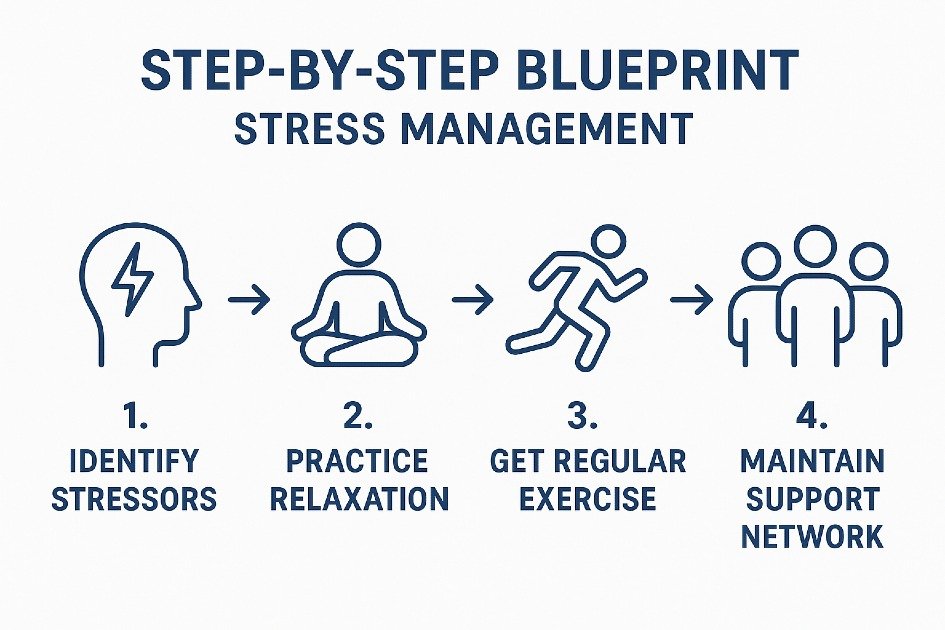Have you ever wondered why, despite trying countless techniques, your stress management efforts never seem to stick?
The truth is, stress management involves understanding its triggers, developing sustainable habits, and applying a structured approach that fits your unique lifestyle, rather than seeking quick fixes or temporary relief.
Harvard Health suggests that stress can be managed by harnessing the body’s self-healing capabilities.
This blueprint identifies effective coping techniques, emphasizing the recognition of internal and external stressors, the use of mindfulness and journaling, and the need for lifestyle adjustments to alleviate chronic tension.
The guide aims to simplify stress management into practical steps, empowering individuals to manage life’s pressures with confidence and promote personal growth.
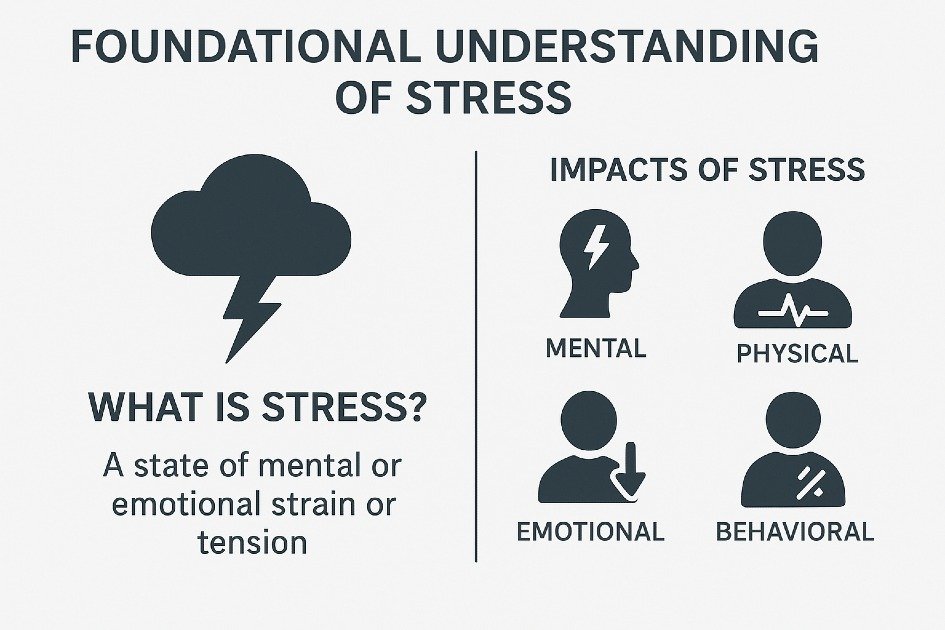
Foundational Understanding of Stress
Stress affects everyone, but learning what causes it helps you act, make slight changes, and stay calmer each day.
Stress Drives How You Live Every Day
Stress is a natural response to challenges, perceived threats, or significant life changes. When understood, it serves as a signal and guide for areas needing attention.
According to American Psychological Association (APA), stress has a natural reaction to life experiences that can be beneficial in short bursts. However, chronic or mismanaged stress poses serious health risks, increasing the likelihood of chronic illnesses.
How to improve:
- Pause and Identify: Notice your stress. Naming it gives you power to manage it.
- Micro-Breaks: Take 5-minute breaks during your day to stretch or breathe deeply.
- Reflective Journaling: Track daily stress triggers spot patterns and find practical ways to manage them.
- Set Realistic Goals: Split big tasks into small steps to stay focused and avoid stress.
I see stress clearly, and I turn pressure into a chance to grow.
How Stress Impacts Your Brain and Body
Stress triggers the fight-or-flight response, releasing hormones like cortisol and adrenaline, leading to increased heart rate, rapid breathing, and heightened alertness. While beneficial in short bursts, chronic stress can cause significant harm.
Chronic stress can seriously impact physical and mental health, leading to high blood pressure, arterial deposits, and brain alterations that increase the risk of anxiety, depression, and addiction, as noted by Harvard Health.
How to improve:
- Mindful Breathing: Deep, slow breaths, lower stress hormones and soothe your nervous system.
- Physical Activity: A 20-minute walk each day helps your body release stress naturally.
- Adequate Sleep: Sleep 7–9 hours each night to let your body rest and repair.
- Relaxation Techniques: Meditation, muscle relaxation, and calming music lower the body’s stress response.
I learned how stress affects my body and mind so I can fight its harmful effects and stay healthy.
Spotting Acute Stress vs Chronic Stress
Acute stress is short-term and can enhance focus and creative problem-solving, while chronic stress is persistent and arises from continuous pressures like work overload, financial issues, or relationship conflicts.
Chronic stress is more harmful than acute stress, resulting in burnout, weakened immunity, and emotional instability. Recognizing the type of stress is essential for effective coping strategies.
How to improve:
- Track Your Stress Duration: Notice how long stress sticks around. Persistent daily annoyances often signal chronic stress.
- Prioritize Problem-Solving: You can ease sudden stress quickly, but long-term stress needs consistent lifestyle changes.
- Professional Support: Counseling, therapy, or coaching helps ease chronic stress effectively.
- Stress-Relief Routines: Fight long-term stress by moving your body, practicing mindfulness, and staying connected with others daily.
When I identify the kind of stress I face, I can manage it in ways that work and stick.
Control stress to improve life and connections
Effective stress management is a crucial life skill that benefits physical health through lower blood pressure and improved immune function. It enhances productivity by fostering focus and decision-making abilities.
Additionally, it strengthens relationships by reducing irritability and improving communication, while also promoting mental clarity and emotional balance.
How to improve:
- Daily Mindfulness Practices: Just 10 minutes of focused attention can lift your mood and boost concentration.
- Prioritize Social Support: Stay connected with friends or support groups to boost your mood and reduce stress.
- Set Boundaries: Say no to protect your energy and focus on what matters.
- Track Progress: Track your stress daily using a journal or app to see real improvements over time.
I manage my stress because it protects my health, boosts my focus, and helps me build stronger relationships.
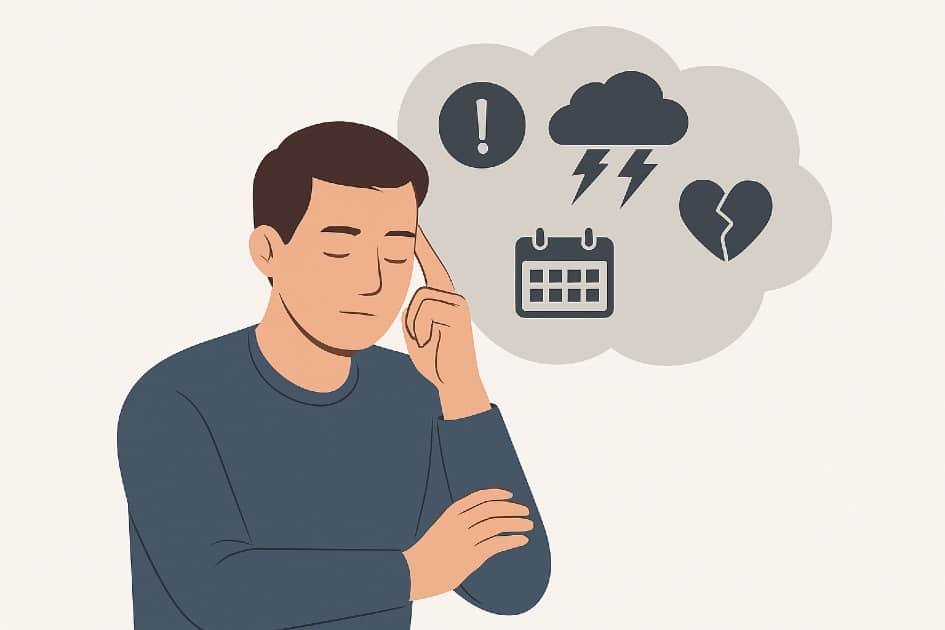
Identifying Your Stress Triggers
Stress often builds up unexpectedly, causing feelings of being overwhelmed. The initial step in stress management is to identify its triggers, which allows for greater control and clarity in responses.
Recognize Common Stress Triggers
Why it matters:
Identifying common stress triggers is essential for effective stress management, as it helps prevent unnecessary tension and reduces the risk of burnout. Recognizing these patterns makes stress management actionable.
How to do it:
- Observe your reactions: Notice what situations make you anxious, irritable, or drained.
- Keep a stress journal: Record what occurred, how you felt, and how your body reacted.
- Look for patterns: Spot the people, places, or events that regularly trigger your stress.
- Categorize triggers: Divide stress into external, like work, traffic, or noise, and internal, like self-criticism, perfectionism, or elevated expectations.
Maria, a marketing manager, felt tense during back-to-back meetings. When she started journaling, she found adding small breaks for reflection eased her stress.
Understand Personal Stress Patterns
Why it matters:
Stress is individualized, with personal triggers differing significantly. Recognizing these unique patterns can lead to customized stress management strategies, enhancing resilience and reducing emotional fatigue.
How to do it:
- Track emotional highs and lows: Track your stress daily by noting its intensity at separate times.
- Notice physical symptoms: Headaches, stiff muscles, or sleepless nights may reveal hidden stress triggers.
- Reflect on past experiences: Recall times you felt stressed—what patterns do you notice?
- Use tools: Using stress tracker helps you spot patterns in your stress over time.
Jake, a freelance designer, realized tight deadlines stressed him more than client meetings. By planning better and setting realistic deadlines, he improved focus and cut his stress.
The Role of Mindset in Stress Perception
Why it matters:
How we interpret situations significantly impacts stress levels; two individuals may encounter the same challenge but respond differently. Cultivating a constructive mindset is essential for effective stress management.
How to do it:
- Reframe negative thoughts: Instead of saying, “I cannot do this,” say, “This is hard, but I can take it one step at a time.
- Practice self-compassion: See mistakes as lessons, not setbacks.
- Adopt a growth perspective: See stress as a prompt to act, not a lasting danger.
- Mindfulness exercises: Just 5 minutes of calm breathing or meditation can change how you see your day.
Emily, a teacher, changed tense parent-teacher meetings into calm reflection sessions. With a new mindset, she managed problems wisely and made better choices.
Journaling and Self-Reflection Techniques
Why it matters:
Journaling serves as a methodical approach to recognize stress triggers, fostering awareness and establishing a feedback loop that enhances stress management.
How to do it:
- Daily reflection: Take 10 minutes to jot down what stressed you today and how you reacted.
- Highlight patterns: Mark repeated stress triggers with simple colors or symbols to spot patterns quickly.
- Ask guiding questions: “What set me off?” “How can I act smarter next time to solve the problem faster?”
- Review weekly: Spot trends and create simple, practical solutions that work.
Tom, a software engineer, tracked his stress during code reviews. By checking his progress each week, he planned better and felt calmer before meetings.
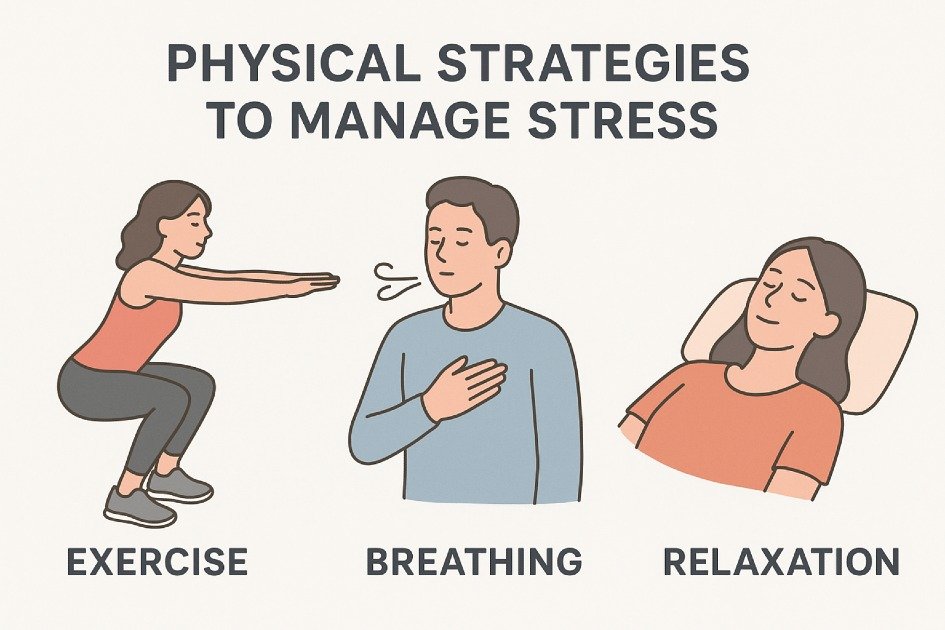
Physical Strategies to Manage Stress
Stress affects both the mind and body. Physical strategies can effectively alleviate tension and improve mood. By recognizing the importance of these methods and learning how to incorporate them into daily routines, stress management can become a practical daily practice.
Exercise as a Stress-Relief Tool
Why it matters:
Exercise promotes the release of endorphins, enhancing mood and reducing stress, while also lowering cortisol levels, improving sleep, and boosting energy. Regular activity strengthens the mind-body connection, aiding in calmer responses to daily stressors.
How to do it:
- Start Small: A quick 15-minute walk at lunch can ease stress and boost your mood.
- Mix Cardio and Strength: Running, cycling, or simple bodyweight moves boost blood flow and build a stronger, more resilient body.
- Incorporate Mind-Body Workouts: Yoga and Pilates help you stay flexible while keeping your mind calm and clear.
- Consistency Over Intensity: Moving every day for just 10–20 minutes is more effective than exercising hard occasionally.
- Personal Story Example: A reader said that a 20-minute morning jog before work helped cut her evening anxiety completely.
I explore high-quality yoga mats and gear that make every workout more comfortable and enjoyable. The right tools help me stay motivated and protect my body while I move.
Calm Your Mind with Simple Breathing
Why it matters:
Deep, intentional breathing can counteract shallow breathing caused by stress, activating the parasympathetic nervous system and inducing a calm state.
How to do it:
- Box Breathing: Breathe in for 4 seconds, hold for four, breathe out for four, pause for 4—do these 5 to 10 times for calm and focus.
- Diaphragmatic Breathing: Put your hand on your belly and feel it move up as you breathe in and down as you breathe out.
- Guided Breathing Apps: Try apps like Pause to guide simple, structured breathing exercises.
- Micro-Breathing Moments: Just 1–2 minutes of deep breathing at work eases tension and refreshes your mind.
Before my exam, I tried box breathing. I felt my heart slow, my mind cleared, and I could focus on the questions.
Sleep Deeply to Boost Energy and Reduce Stress
Why it matters:
Sleep boosts your mood, sharpens your thinking, and strengthens your ability to manage stress. Insufficient restorative sleep raises cortisol levels, complicating stress management. Quality sleep aids in body repair, hormonal balance, and enhances problem-solving skills.
How to do it:
- Set a Consistent Schedule: Sleep and wake at the same time every day to keep your body clock steady and boost energy.
- Create a Sleep Sanctuary: Keep your bedroom dark, cool, and quiet. Remove phones, TVs, and other distractions to help your body rest deeply and wake up refreshed.
- Limit Screen Time: Avoid screens for at least an hour before bedtime to protect your sleep from blue light.
- Wind-Down Rituals: Read a book, stretch lightly, or soak in a warm bath.
- Sleep Tracking Tools: Smart sleep devices track your sleep and help you rest better.
A burned-out manager started turning off devices at 10 PM. In two weeks, her mind felt calmer, and stress headaches eased.
Nutrition and Stress
Why it matters:
Diets high in sugar and processed foods can increase stress hormones, while nutrient-rich foods enhance brain function, regulate cortisol, and stabilize mood. Intentional nutrition significantly improves stress management.
How to do it:
- Focus on Whole Foods: Eating vegetables, fruits, lean proteins, and whole grains boosts energy and keeps your mood steady.
- Include Omega-3s: Eating fatty fish, flax seeds, and walnuts can lower stress-related inflammation.
- Stay Hydrated: Even if you are slightly dehydrated, it can increase stress and get your body tired faster.
- Mindful Eating: Eat slowly, enjoy each bite, and focus on your meal without distractions.
- Supplements: Use magnesium or ashwagandha to help your body manage stress.
A freelancer started eating oats, nuts, and berries for breakfast. After a month, her mornings felt calmer, and her energy stayed steady throughout the day.
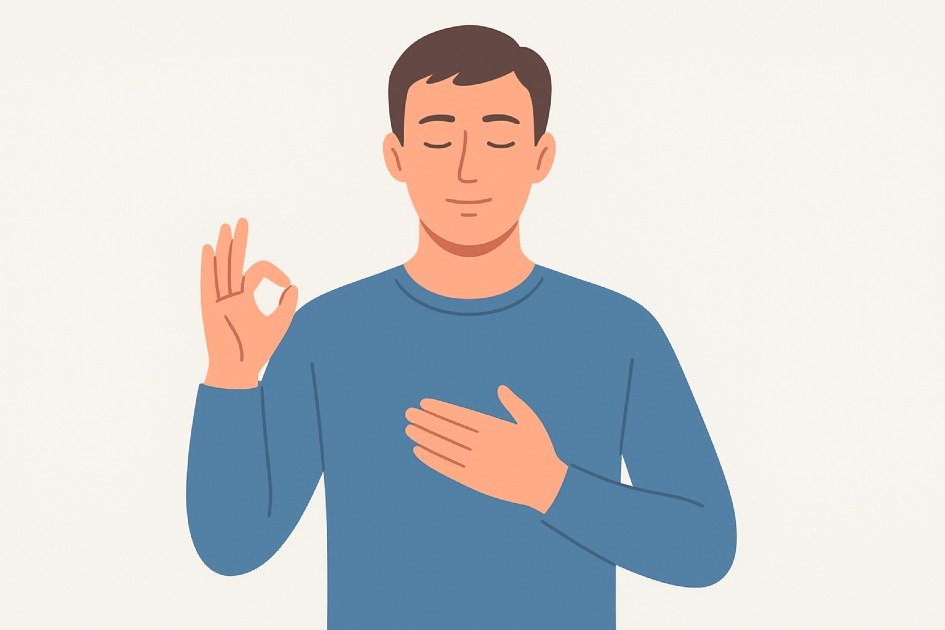
Master Your Mind and Calm Your Emotions
Stress manifests in thoughts, emotions, and interactions, making mental and emotional management essential for clarity, focus, and calm. Responding thoughtfully instead of reacting impulsively can alleviate tension and enhance well-being.
Mindfulness and Meditation Practices That Work
Why it matters:
Mindfulness helps individuals recognize stress without being overwhelmed, while meditation alters neural pathways to enhance resilience against daily pressures. Research indicates that consistent mindfulness practice decreases anxiety, enhances concentration, and improves emotional regulation.
How to do it:
- Start Small: Start your day with 5 minutes of mindful breathing. Slowly work up to 15–20 minutes for calmer mornings and clearer focus.
- Anchor Your Senses: Notice the sounds, smells, and feelings around you to stay in the moment.
- Guided Sessions: Follow guided meditation for daily focus and calm.
- Mindful Moments: Stop before reacting—observe your feelings and thoughts, then choose your response.
A corporate professional started meditating for 10 minutes daily. In three weeks, he noticed sharper focus in meetings and fewer tension headaches.
Challenge Stress with Smarter Thinking
Why it matters:
Stress is often a result of distorted thinking such as catastrophizing or overgeneralization. Cognitive Behavioral Therapy (CBT) assists in identifying and reframing these negative thought patterns, resulting in calmer responses and improved decision-making.
How to do it:
- Recognize Triggers: Write down stressful thoughts to spot patterns and calm your mind.
- Challenge Your Thoughts: Check if your thought is fact or just an assumption.
- Reframe Positively: Change ‘I cannot do this’ to ‘I will manage it one step at a time.’
- Daily Practice: Spend 10–15 minutes daily writing in a journal to reflect and gain clarity.
Jane, a teacher, felt stressed by constant parent emails. Using CBT, she changed her thoughts and felt confident instead of anxious.
Emotional Release Strategies
Why it matters:
Suppressing emotions increases stress, while expressing feelings aids in processing experiences, alleviating mental strain and preventing burnout. Creative outlets offer catharsis and improve emotional clarity.
How to do it:
- Journaling: Jot down all your stressors. Let your thoughts flow without holding back.
- Talk It Out: Talk openly with trusted friends, mentors, or a therapist to lighten your emotional load.
- Creative Expression: Express your feelings through painting, music, or storytelling to release and understand emotions.
- Scheduled Reflection: Take 20 minutes each night to reflect and let go of stress.
Mark, a software engineer, used evening sketching sessions to manage work-related stress. Over time, his mood stabilized, and creativity improved.
Use Visualization to Turn Stress into Calm
Why it matters:
Visualization enhances mental resilience by eliciting relaxation responses and diminishing stress reactions through the imagination of positive outcomes or serene scenarios.
How to do it:
- Create a Safe Space: Imagine a peaceful place—soft green grass under your feet, gentle birdsong in the air, and the fresh scent of flowers around you.
- Future Visualization: Picture yourself staying calm and confident while managing a tough task or conflict.
- Daily Practice: Take 5–10 minutes to imagine success before a stressful event.
- Combine with Breathing: Breathe deeply as you picture calm scenes to boost relaxation.
Master Daily Stress with Simple Techniques
Integrating mindfulness, CBT, emotional release, and visualization form an effective stress management routine.
Begin with one or two techniques, practice them consistently, and expand gradually. These methods enhance emotional regulation over time, making it more automatic and natural.
How to do it:
- Morning Mindfulness: Start your morning with meditation to stay calm and focused all day.
- Midday Journaling: Tackle morning hurdles and refresh your mindset for a strong start.
- Evening Visualization: Face morning challenges and clear your mind. Reflect on today and picture a calm, positive tomorrow.
- Weekly Reflection: Track what works, then tweak your routine for better results.
I use these techniques every day, so that I can manage stress before it builds. Small, steady actions keep me strong and clear-minded.
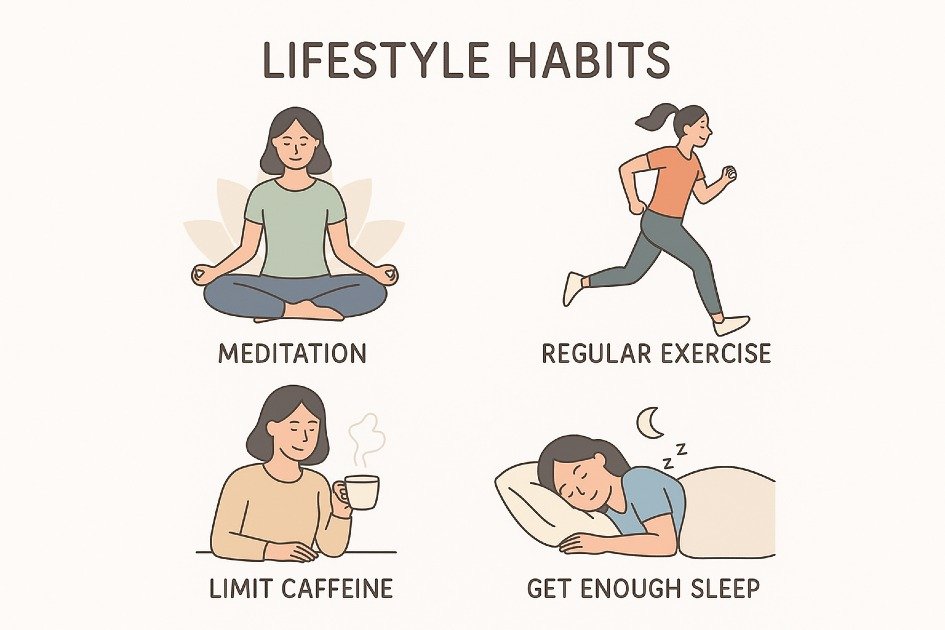
Lifestyle Habits to Reduce Stress Daily
Stress management can be simplified through small, intentional lifestyle changes. By adopting practical habits into your daily routine, you can foster calm, enhance focus, and boost resilience, making stress management a regular part of your life.
Build a Morning Routine That Sets a Calm Tone
Why it matters:
Establishes a positive daily tone, alleviates morning anxiety, promotes consistency to decrease stress hormones, and creates room for mental clarity and goal setting.
How to do it:
- Set your alarm 30 minutes earlier to start the day calm and in control.
- Practice mindfulness daily through meditation, journaling, or gratitude exercises.
- Drink water in the morning to boost metabolism and sharpen focus.
- Plan tonight to set out clothes, prep meals, and list tasks to start your morning smoothly.
- Delay checking your phone to prevent stress and information overload.
Sarah, a busy marketer, spent 15 minutes each morning meditating. In weeks, she felt calmer, with fewer panic spikes and a clearer mind.
Time Management Strategies to Avoid Overwhelm
Why it matters:
Creates a sense of control, preventing chronic stress; helps prioritize high-value tasks to reduce mental strain; encourages a balanced life with time for rest and personal care.
How to do it:
- Block out time for each task to stay focused and work efficiently.
- Focus on what matters by sorting tasks with the Eisenhower Matrix: urgent versus important.
- Focus on one task at a time to work faster and keep your mind sharp.
- Take regular breaks to refresh your mind and avoid burnout.
- Use planners or productivity apps to track your goals and daily progress.
John, an entrepreneur, felt overwhelmed by constant emails. By using time blocks, he cut stress and freed his mind for creative ideas.
Say No Confidently and Protect Your Time
Why it matters:
Learning to say no respectfully helps manage stress by protecting time and energy, preventing overextension and emotional exhaustion, reinforcing personal priorities, improving work-life balance, and empowering self-respect and confidence.
How to do it:
- Know your limits at work and in life to stay balanced and focused.
- Say no confidently without over-apologizing.
- Suggest other options to stay connected without saying yes to everything.
- Block time for rest and treat it as essential.
- Review past commitments to spot patterns and prevent overloading yourself.
When Emily began saying no to extra volunteer tasks, her stress eased, and she gained more time for personal growth and mindfulness.
Cultivate a Support Network for Emotional Resilience
Why it matters:
Human connection acts as a strong buffer against stress by providing emotional support, reducing isolation, and encouraging accountability for healthy stress management.
How to do it:
- Check in often with friends, family, or mentors to stay connected and supported.
- Connect with wellness or stress support groups to share tips and stay motivated.
- Have real conversations, not just quick hellos.
- Help others—building connections that ease your own stress.
- Join workshops or events that match your interests to meet people and learn new skills.
Mike, healing from burnout, joined a mindfulness group. Talking and learning with others eased his anxiety and built his resilience.
Practice Quick Mindfulness All Day
Why it matters:
Mindfulness can be integrated into daily life beyond meditation, promoting stress reduction and mental clarity. It effectively interrupts stress cycles, enhances emotional regulation, and improves cognitive focus, contributing to long-term resilience against daily stressors.
How to do it:
- Pause and take three deep breaths before replying to stressful emails or chats.
- Focus on what you feel when walking or eating to stay present.
- Try 2–5-minute mindfulness apps for a quick mental reset anytime.
- Take a moment before deciding to clear your mind and think clearly.
- Each night, review stressful moments and how you responded.
Lisa, a high school teacher, added two short mindful breathing breaks to her day. She felt calmer and more focused, creating a better classroom experience for her students.
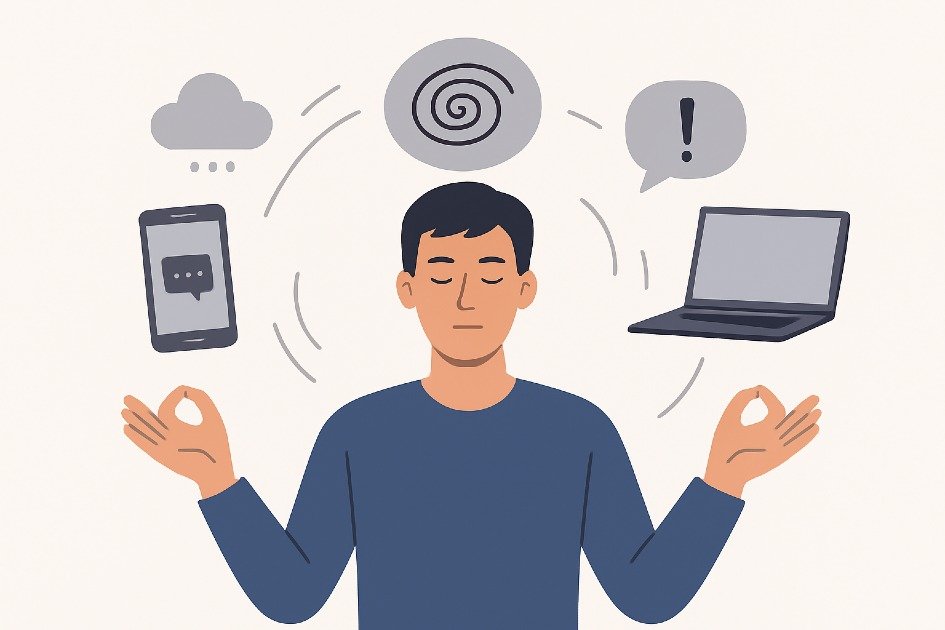
Technology and Stress
In an increasingly connected world, technology can simplify life but may also heighten stress and diminish mental resilience. Effectively navigating the digital landscape is essential for stress management.
Digital Detox Strategies for Mental Clarity
Why it matters:
Constant notifications and scrolling heighten alertness, triggering cortisol release, which causes fatigue and anxiety. Intentional breaks can reset the nervous system and enhance mental clarity.
How to do it:
- Set daily tech-free times, like at meals or right after waking, to reset your mind and boost focus.
- Pick one day each week to go almost screen-free mini digital retreat for your mind.
- Swap endless scrolling for mindful habits like reading, journaling, or walking outdoors.
- Use apps like RescueTime to monitor your screen habits and spot time-wasting patterns.
Sarah, a marketing professional, often felt headaches and irritability after long screen time. She started taking two-hour tech-free breaks each night, which improved her sleep and boosted her focus and calm.
Control Alerts and Clear Your Mind
Why it Matters:
Constant notifications disrupt focus and elevate mental fatigue, as each alert forces the brain into task-switching mode, which diminishes productivity and heightens stress levels.
How to do it:
- Mute unnecessary notifications on your phone and computer to stay focused and reduce stress.
- Turn on ‘Do Not Disturb’ during work or personal time to focus and protect your energy.
- Clear your inbox by unsubscribing from emails you do not need.
- Check social media and messages at set times to manage notifications in batches.
A software engineers limited notifications to urgent calls and emails. In just two weeks, he felt calmer and finished work faster.
Monitor Your Mood and Stress Easily with Apps
Why it Matters:
Some technology may be beneficial for stress management by tracking mood, meditation, or sleep quality, provided it is used intentionally rather than mindlessly.
How to do it:
- Use apps like Mindful.org to practice guided meditation and reduce stress.
- Track moods and triggers with apps like Daylio to spot patterns fast.
- Use reminders to take deep breaths, stretch, or drink water throughout the day.
- Check apps at set times, not all day.
Miguel, a college student, felt stressed before exams. A mood-tracking app showed that late-night social media worsened his anxiety. Changing his routine helped him focus better and feel calmer.
Steps for Healthy Tech Habits
Why it matters:
Small, manageable changes in digital life can alleviate overwhelm, reduce cortisol spikes, improve focus, and enhance overall well-being over time.
How to do it:
- Leave your phone outside of the bedroom to sleep deeper and wake refreshed.
- Turn on blue-light filters at night to keep your sleep cycle healthy
- Keep dining areas screen-free to boost family focus and mealtime connection.
- Pick offline hobbies like cooking, painting, or reading books to relax and boost focus.
A family banned phones at dinner. They noticed better conversations, less tension, and stronger connections—showing that setting tech limits can lower stress.
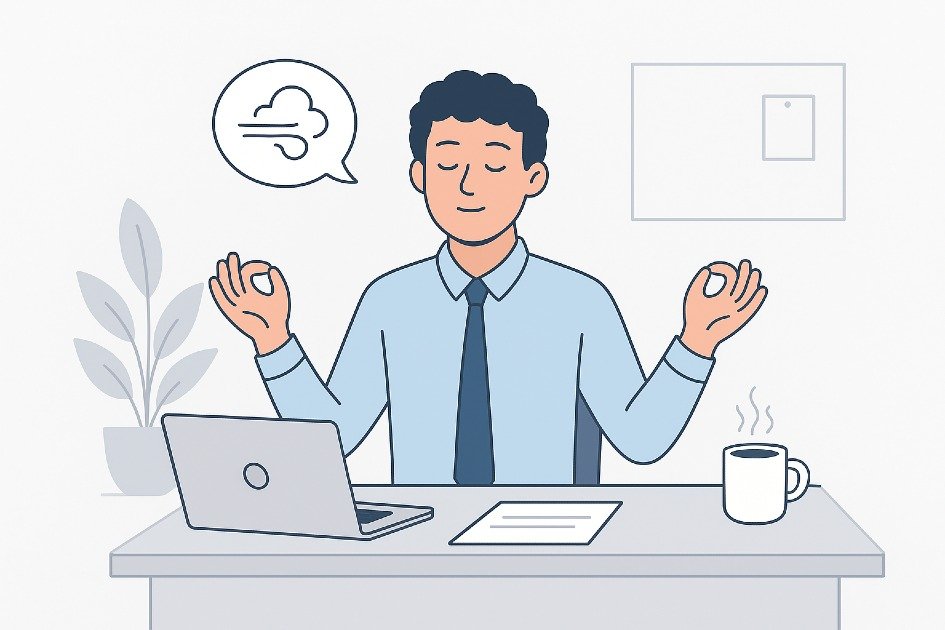
Stress Management at Work
Work can be a significant source of stress, but by implementing intentional strategies, it is possible to alleviate tension, enhance productivity, and promote a healthier mindset.
Effective stress management in the workplace focuses on thriving professionally while safeguarding personal well-being.
Identifying Workplace Stressors
Why it matters:
Identifying unrecognized stressors is crucial for effective stress management, as they can negatively affect focus, energy, and relationships with colleagues.
How to do it:
- Reflect Daily: Spend 5 minutes after work writing down what frustrated or stressed you today.
- Track Patterns: Use a small journal or app to track patterns and identify stress triggers.
- Seek Feedback: Check in with coworkers or your boss to get feedback on your tasks and work habits.
- Categorize Stressors: Sort challenges into what you can control and what you cannot. Focus your energy on what you can act on.
Sarah, a project manager, felt stressed during back-to-back meetings. She tracked her week and saw that some meetings could be shortened or handed off. This simple change eased her stress a lot.
Creating a Balanced Workload
Why it matters:
Overcommitting can result in chronic stress, burnout, and reduced performance. Effective stress management requires aligning the workload with realistic capabilities.
How to do it:
- Prioritize Tasks: Spot tasks that make the biggest difference and do them first.
- Break Tasks into Steps: Breaking tasks into small steps keeps stress low and progress steady.
- Delegate When Possible: Delegate tasks others can do well to free your time for what matters most.
- Set Boundaries: Politely decline tasks that do not matter, so you can focus on what truly counts.
James, a software developer, used a task matrix to sort urgent and important work. This slight change helped him focus on what mattered most, boosting his productivity and mental well-being.
Quick Desk Exercises and Micro-Breaks
Why it matters:
Sitting for extended periods under tight deadlines can heighten stress, fatigue, and tension. Taking brief physical breaks revitalizes the body and mind, enhances focus, and lowers stress hormones.
How to do it:
- Stretch Regularly: Rolling shoulders, stretching your neck, and rotating wrists ease tension fast.
- Practice Deep Breathing: Just 2–3 minutes of deep belly breathing can quickly reduce stress hormones.
- Walk Briefly: A short walk indoors or outdoors refreshes your mind instantly.
- Micro-Meditations: Close your eyes, imagine calm, and refresh your mind.
Maria, a financial analyst, took two 5-minute walking breaks each day. After a month, she felt less tired and managed tight deadlines more easily.
Speak Clearly to Ease Stress
Why it matters:
Miscommunication increases workplace stress, while clear and proactive communication helps prevent misunderstandings, reduce conflict, and create a cooperative environment, all of which are vital for effective stress management.
How to do it:
- Be Direct but Respectful: State your needs and expectations clearly, without blaming others.
- Practice Active Listening: Listen to understand, not just to answer.
- Provide Constructive Feedback: Give answers, not just complaints.
- Check-in Regularly: Quick check-ins with teammates stop surprises and cut stress.
Tom held weekly team check-ins. Tasks became clearer, deadlines were easier to track, and the team felt less stressed.
Use Tech Smartly for Better Results
Why it matters:
Smart use of technology can enhance stress management at work, countering the amplification of stress from constant notifications, emails, and digital distractions.
How to do it:
- Set Notification Limits: Silence non-essential notifications to stay focused and work efficiently.
- Use Task Management Apps: To organize your work and focus on what matters most.
- Schedule Email Windows: Set specific times to check emails instead of responding constantly.
- Utilize Mindfulness Apps: For quick guided exercises to reduce stress anytime.
Laura, a marketing coordinator, set two 45-minute daily focus sessions with notifications off. She finished important tasks faster and felt less stressed each day.
Boost Strength and Stay Steady at Work
Why it matters:
Short-term fixes may provide temporary relief, but effective stress management in the workplace necessitates building resilience, enabling individuals to cope with future challenges without becoming overwhelmed.
How to do it:
- Develop a Growth Mindset: Turn every challenge into a chance to grow.
- Seek Mentorship: Advice from experienced coworkers lowers stress and clears uncertainty.
- Maintain Work-Life Balance: Set aside daily time to rest and recharge beyond work.
Daniel, an account manager, celebrated small wins each week. Gradually, his confidence grew, stress eased, and he stayed clear of burnout.
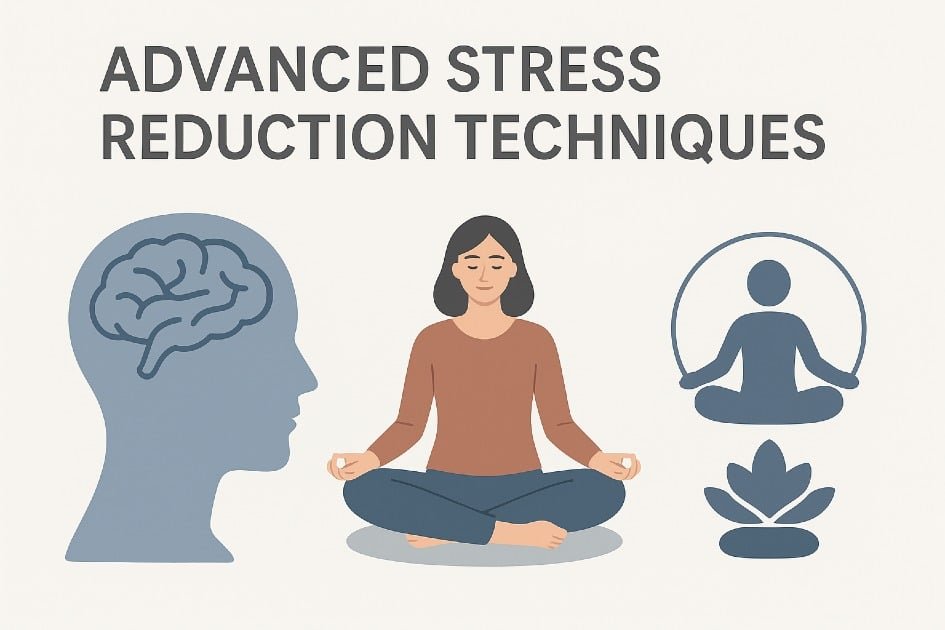
Advanced Stress Reduction Techniques
Stress management involves developing a comprehensive set of techniques that effectively address both physical and mental aspects, moving beyond mere relaxation to achieve lasting control over stress levels.
Progressive Muscle Relaxation
Why it matters:
Stress can lead to physical symptoms like muscle tightness and headaches. Progressive Muscle Relaxation (PMR) helps the body recognize and consciously release tension, reducing immediate stress and retraining the nervous system to stay calm under pressure.
How to do it:
- Sit or lie down in a calm, quiet spot.
- Tighten each muscle from your toes up for 5–10 seconds, then let it go.
- Relax each body part step by step—start with your feet, then legs, abdomen, hands, arms, shoulders, and finish with your face.
- Notice how your body feels when it tenses and relaxes, paying attention to the change in sensation.
- Spend 10–15 minutes daily to strengthen your stress resilience.
I combine PMR with deep breathing to feel calmer. I follow calming audio guides to stay on track.
Train Your Body to Respond Differently
Why it matters:
Biofeedback provides real-time insights into physiological responses triggered by stress, such as increased heart rate and shallow breathing.
This technique helps individuals manage stress before it escalates, reducing chronic symptoms and enhancing mental clarity over time.
How to do it:
- Track your stress with a biofeedback device that measures your heart rate, skin temperature, or muscle tension.
- Start with brief sessions and notice how your body responds to stress.
- Use deep breathing or mental imagery and feel the difference instantly.
- Slowly make your sessions longer and harder to build a stronger stress response.
After 6 weeks of biofeedback training, a 35-year-old professional cut their anxiety by 30%, showing its clear effect on managing stress.
Nature Therapy
Why it matters:
Spending time in nature lowers cortisol levels, improves mood, and enhances cognitive function, serving as a natural stress buffer that promotes mental and physical recovery through activities like forest walks, gardening, and urban green spaces.
How to do it:
- Spend 20–30 minutes outside each day, preferably in parks or gardens.
- Awaken your senses by hearing birds, feeling leaves, and noticing colors and textures.
- Boost your well-being by pairing time in nature with deep breaths or gentle stretches.
- Take weekend nature retreats to refresh your mind and lower stress.
When I spend time walking in the forest, I feel calmer, and my blood pressure drops.
Boost Balance Using Yoga, Tai Chi, and Breathwork
Why it matters:
Mind-body disciplines combine movement, meditation, and controlled breathing to effectively combat stress. They enhance flexibility, relieve tension, and foster mindfulness, which are crucial for managing stress.
How to do it:
- Yoga: Do gentle yoga like Hatha or Yin for 15–30 minutes a day. Focus on poses that open your chest, shoulders, and hips to improve flexibility and calm your mind.
- Tai Chi: Move slowly and mindfully, matching your breath with each motion to build inner calm.
- Breathwork: Practice simple methods like Box Breathing (breathe in for 4 seconds, hold for four, exhale for four, hold for 4) or Alternate Nostril Breathing to calm your mind and balance your body.
- Consistency matters: Spend just 10–15 minutes a day to see actual results.
I use high-quality mats, follow guided apps, and join online classes like Tai Chi Online Program to make my practice easier and more effective.
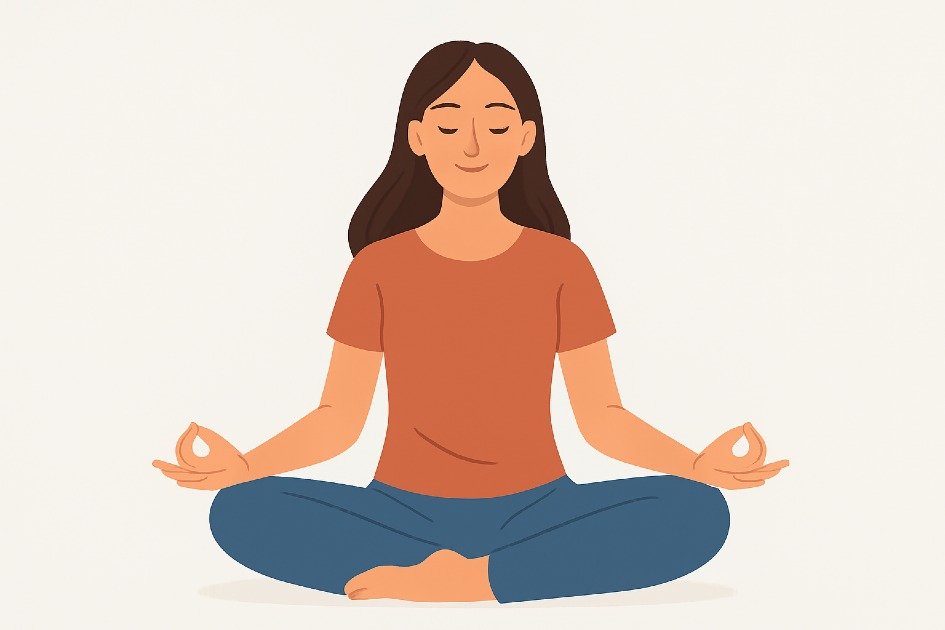
Maintaining Long-Term Stress Resilience
Building long-term stress resilience involves navigating stress effectively rather than eliminating it. By incorporating sustainable practices into daily life, stress management transforms from a chore into a lifestyle.
Master Daily Habits to Transform Your Life
Why it matters:
Small, consistent habits enhance stress resilience by automating positive behaviors and decreasing the mental load of decision-making, a common stressor.
How to do it:
- Start Small: Start small with simple habits—try 5 minutes of morning meditation or one deep-breathing exercise after work.
- Anchor to Existing Routines: Link a new habit to one you already do — like writing in your journal right after brushing your teeth.
- Track Progress: Track your progress with a journal or app. Watching your streaks grow keeps you motivated and consistent.
- Reward Yourself: Reward yourself with small treats after finishing a task to build strong, lasting habits.
- Review and Adjust: Check what works often; staying flexible keeps stress strategies effective and prevents burnout.
I started meditating just 3 minutes each morning. After a month, my afternoon energy stayed steady, and my focus improved. Small daily habits really add up.
Recap: Empower Yourself with Stress Mastery
Achieving a state of equilibrium with effective stress management is possible through understanding triggers and practicing resilience daily.
A holistic approach—balancing lifestyle and nurturing mental health—is crucial for developing true resilience.
Advanced methods such as progressive muscle relaxation and mindfulness enhance the ability to respond to stress constructively.
Harvard Health highlights the importance of understanding and managing your body’s stress responses. Techniques such as mindfulness, yoga, and sufficient sleep can significantly alleviate stress and improve overall well-being.
Investing in well-being today creates a foundation for improved quality of life and lasting calm for long-term benefits.
Embracing these strategies not only reduces stress but empowers personal growth and harmony; knowing that stress management is a lifelong investment in one’s peace and potential.
Frequently Asked Questions
How quickly can I expect to see results from stress management techniques?
The timeline for stress management relief varies by individual. Some may see improvements in days with techniques like deep breathing or mindfulness meditation, but lasting benefits require consistent practice over weeks or months. Regular practice fosters deeper resilience and enduring changes in stress management.
Are there specific exercises that work best for stress relief?
Some exercises work best to reduce stress quickly and boost your mood:
- Aerobic activities: Walking, jogging, or cycling raises endorphins, naturally lifting your mood.
- Yoga and Tai Chi: These exercises pair movement with mindfulness to ease tension and calm the mind.
- Strength training: Doing strength exercises regularly boosts sleep and eases anxiety.
Adding these exercises to your daily routine can boost your ability to manage stress.
Can diet really affect my stress levels?
Yes! Your diet directly shapes how your body handles stress.
- Caffeine and sugar: Eating too much can raise anxiety and disturb your sleep.
- Balanced meals: Eating fruits, vegetables, lean proteins, and whole grains boost health and keeps your mood steady.
- Hydration: Drinking enough water boosts brain power and helps control stress.
Eating a balanced diet helps your body handle stress better.
How do I stay consistent with stress management practices?
Stick with stress management daily to see actual results.
- Set realistic goals: Set tiny, doable goals to gain momentum fast.
- Create a routine: Add stress-relief activities to your daily routine to make them a habit.
- Track progress: Track your stress in a journal to see what techniques really help you stay calm.
- Seek support: Connect with friends, family, or support groups to stay motivated and on track.
Use these strategies to stay consistent in managing stress.
Is stress always harmful, or can it be beneficial in some cases?
Short bursts of stress can boost focus and performance, while long-term stress harms your health.
- Motivation: Stress can push you to finish tasks and hit deadlines faster.
- Focus: It boosts focus and sharpens alertness in tough situations.
- Resilience: Facing stress strengthens your emotions and helps you adapt better.
Manage stress wisely to use its benefits and reduce its harm.
How can I support a loved one struggling with stress?
Help someone under stress by listening with care and offering simple, practical support by:
- Listen actively: Listen without judging and show you care about their feelings.
- Encourage healthy habits: Do activities like walking, yoga, reading, or painting to relax your mind and body.
- Respect boundaries: Know when they want alone time and when they need company.
- Seek professional help: If stress causes strong anxiety or depression, seek help from a mental health professional.
What are the signs that professional help is needed for stress?
Know the signs when stress is out of control:
- Persistent anxiety: Constant worry or fear that disrupts everyday life.
- Physical symptoms: Headaches, stomach troubles, or poor sleep can signal hidden stress in your body.
- Emotional changes: Frequent mood swings, irritability, or feelings of hopelessness can signal underlying stress or mental health issues.
- Withdrawal: Avoiding social activities or personal responsibilities can increase stress and isolation.
If these signs keep happening, talk to a doctor or mental health expert for help.
Can mindfulness really change how my brain manages stress?
Mindfulness changes the brain to help you manage stress better by:
- Reduced activity in the amygdala: Practicing mindfulness lowers how strongly your brain reacts to stress.
- Increased prefrontal cortex activity: This part of the brain helps you make choices and control your emotions.
- Enhanced emotional regulation: Practicing mindfulness daily helps you control your emotions better.
Practicing mindfulness daily can train your brain to manage stress better.
How can I manage stress during major life transitions?
Big life changes—like moving, starting a new job, or losing someone—can trigger strong stress.
- Accept change: Accept that change happens in life and use it to grow.
- Stay connected: Stay close to friends and family who lift you up.
- Establish routines: Build simple daily routines to bring stability and focus.
- Seek professional support: Seek therapy to manage difficult emotions effectively.
Managing stress early helps you adjust quickly to change.
Are there any tools or apps that genuinely help track and reduce stress?
You can track and manage stress with easy-to-use apps and tools:
- Mindful.org: Provides guided meditation to help you relax and ease stress.
- Calm: Offers guided sleep stories, easy breathing exercises, and simple mindfulness practices.
- MyLife Meditation: Tracks your mood and recommends activities to lift your spirits.
- Stress Check by Azumio: Tracks heart rate changes to reveal your stress levels.

